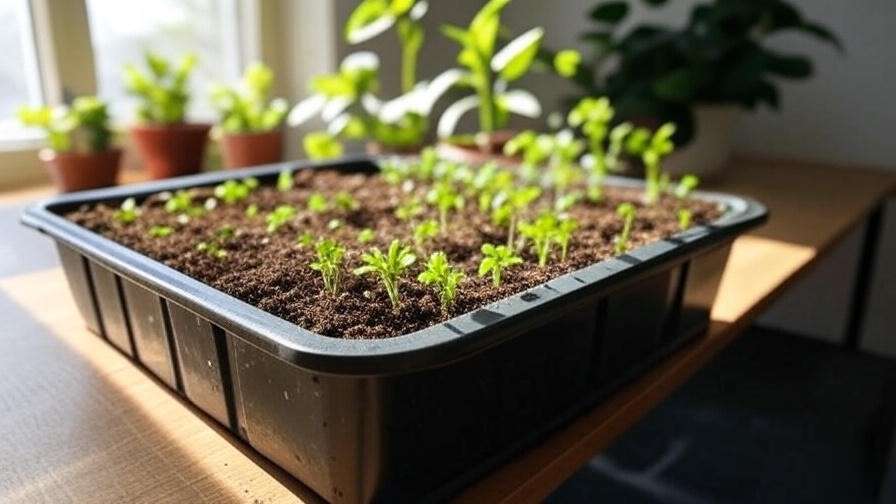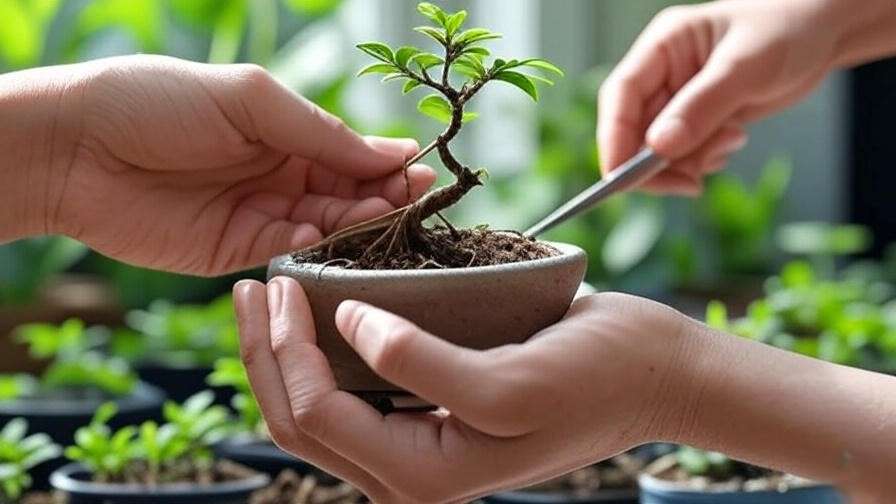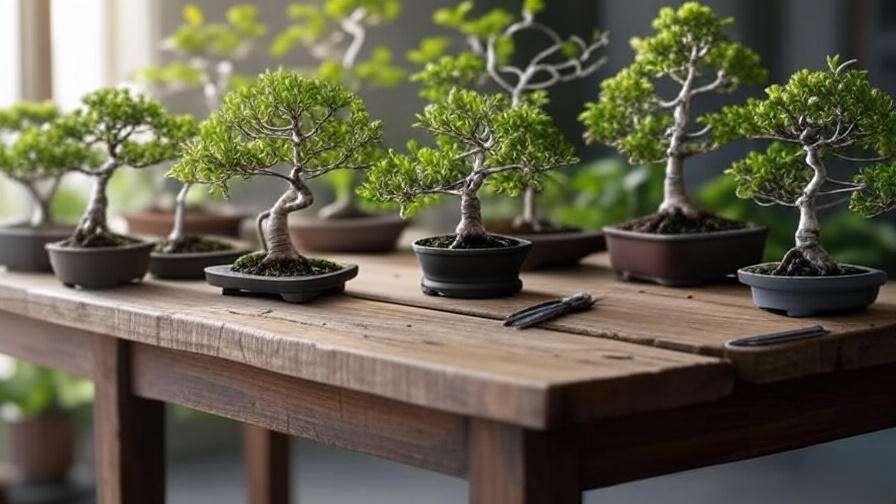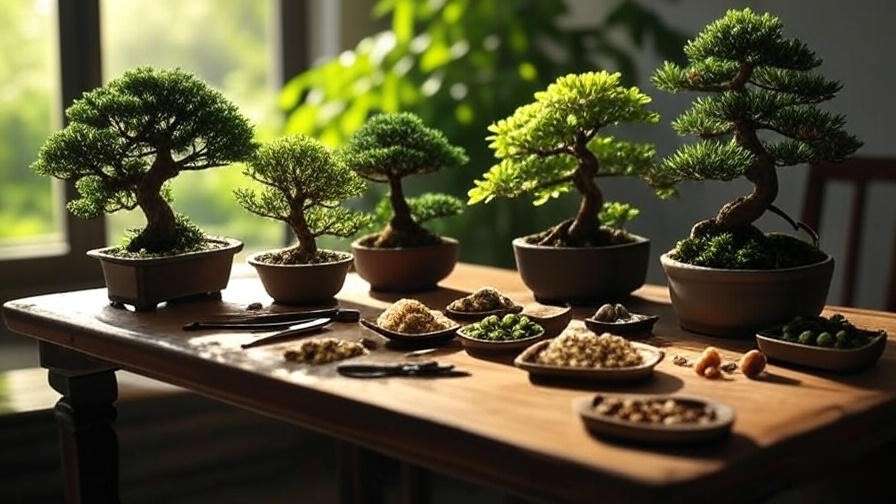Picture a tiny seed, no larger than a grain of rice, blossoming into a majestic bonsai tree that brings tranquility and beauty to your home 🌿. Growing bonsai tree seeds is a rewarding journey that blends patience, creativity, and a deep connection to nature. Whether you’re a plant enthusiast or a curious beginner, cultivating bonsai from seeds offers a unique opportunity to craft living art. This comprehensive guide will walk you through every step of the process, from selecting the perfect seeds to shaping miniature masterpieces. Backed by insights from bonsai experts and horticultural research, this article provides all the tools you need to succeed, ensuring your bonsai journey is both fulfilling and fun! 🌸
Understanding Bonsai Tree Seeds 🌸
What Are Bonsai Tree Seeds?
Bonsai tree seeds are not a special variety but rather seeds from tree species suitable for bonsai cultivation, such as Japanese Maple, Black Pine, or Ficus. The magic of bonsai lies in training these trees to remain small while maintaining the appearance of full-sized trees. Common species include:
- Japanese Maple (Acer palmatum): Known for vibrant red or green foliage, ideal for temperate climates.
- Black Pine (Pinus thunbergii): A hardy evergreen with rugged bark, perfect for classic bonsai styles.
- Ficus Retusa: A tropical species that thrives indoors, with glossy leaves and aerial roots.

Myth busted: There’s no such thing as “bonsai-specific” seeds. Any tree seed can become a bonsai with proper care and training. Understanding your seed type is the first step to success, as each species has unique growth patterns and care needs.
Why Grow Bonsai from Seeds?
Growing bonsai from seeds is a labor of love that offers unmatched rewards. Here’s why it’s worth the effort:
- Cost-effective: Seeds are far cheaper than pre-grown bonsai trees.
- Full control: You shape the tree from its earliest stages, tailoring it to your vision.
- Emotional connection: Nurturing a tree from seed fosters a deep bond, as noted by bonsai master John Naka: “A bonsai is not just a plant but a living sculpture you grow with.”
However, growing from seeds requires patience, as it can take 2–5 years to achieve a recognizable bonsai shape. The challenge is part of the meditative joy, making it ideal for those seeking a long-term, rewarding hobby.
Choosing the Right Bonsai Tree Seeds 🌳
Factors to Consider When Selecting Seeds
Choosing the right bonsai tree seeds sets the foundation for success. Consider these factors:
- Climate compatibility: Match the species to your local environment. Tropical species like Ficus thrive in warm climates, while pines and maples suit cooler regions.
- Aesthetic preferences: Decide on leaf size, bark texture, or growth patterns (e.g., upright, cascading). For example, Japanese Maples offer delicate leaves, while junipers provide rugged charm.
- Seed quality: Purchase from reputable suppliers to ensure viability. Look for fresh, well-stored seeds with clear germination instructions.
Top Bonsai Seed Recommendations for Beginners
Here are beginner-friendly species with their key traits:
| Species | Growth Rate | Care Level | Best For |
|---|---|---|---|
| Japanese Maple | Moderate | Medium | Temperate climates, vibrant foliage |
| Dwarf Juniper | Slow | Easy | Outdoor bonsai, hardy |
| Ficus Retusa | Fast | Easy | Indoor bonsai, tropical |
Tip: Start with Ficus or Juniper if you’re new, as they’re forgiving and adapt well to beginner mistakes.
Preparing to Plant Bonsai Tree Seeds 🛠️
Essential Tools and Materials
To grow bonsai tree seeds successfully, gather these essentials:
- Seed trays or small pots: Ensure proper drainage to prevent waterlogging.
- Bonsai soil mix: A blend of akadama, pumice, and lava rock (1:1:1 ratio) for drainage and aeration.
- Watering can with fine nozzle: For gentle watering.
- Humidity dome or plastic wrap: To maintain moisture during germination.
- Optional: Heat mats for consistent temperature, tweezers for precision planting.
Expert Tip: Sterilize all tools with rubbing alcohol to prevent fungal infections, a common issue with seedlings.
Understanding Seed Dormancy and Stratification
Many bonsai tree seeds, like those of maples or pines, have a natural dormancy period to survive winter. Breaking this dormancy through stratification is key to germination:
- Soak seeds: Place seeds in lukewarm water for 24–48 hours to soften the seed coat.
- Cold stratification: Wrap soaked seeds in damp sphagnum moss or paper towels, seal in a plastic bag, and refrigerate at 35–40°F (2–4°C) for 30–90 days, depending on the species.
- Monitor moisture: Check weekly to ensure the medium stays damp but not soggy.
Visual Aid: A stratification diagram would show seeds in a damp medium, sealed in a bag, and placed in a refrigerator.
Step-by-Step Guide to Planting Bonsai Tree Seeds 🌱
Step 1: Preparing the Seeds
After stratification (if required), prepare seeds for planting:
- Soaking: Soak seeds again for 24 hours to further soften the coat.
- Scarification (if needed): For hard-coated seeds like wisteria, gently nick the seed coat with sandpaper or a knife to aid water absorption.

Step 2: Sowing the Seeds
- Fill seed trays with a bonsai soil mix (akadama, pumice, organic compost in a 1:1:1 ratio).
- Plant seeds 1–2 cm deep, spacing them 2–3 cm apart to avoid overcrowding.
- Cover with a thin layer of soil and mist gently with water.
Step 3: Creating Optimal Germination Conditions
To encourage germination:
- Moisture: Keep soil consistently moist but not waterlogged. Use a spray bottle to mist daily.
- Temperature: Maintain 65–75°F (18–24°C), using a heat mat if needed.
- Humidity: Cover trays with a humidity dome or plastic wrap to retain moisture.
- Light: Place in indirect sunlight to prevent overheating.
Tip: Check soil daily to ensure it’s moist but not soggy, as overwatering can cause rot.
Step 4: Monitoring Germination
Germination times vary by species:
- Ficus: 2–4 weeks.
- Japanese Maple: 4–8 weeks.
- Pines: 6–8 weeks.
Once sprouts emerge, remove the humidity cover to prevent mold. If germination is slow, check for:
- Improper stratification: Ensure seeds underwent the correct cold period.
- Poor seed quality: Test viability by checking if seeds sink in water (viable seeds sink).
- Excess moisture: Reduce watering to prevent fungal growth.
Caring for Bonsai Seedlings 🌿
Watering and Feeding Young Seedlings
Seedlings are delicate and require careful nurturing:
- Watering: Use a fine mist or bottom-watering (place tray in shallow water) to avoid disturbing roots. Water when the soil surface feels dry.
- Feeding: After 4–6 weeks, introduce a diluted liquid fertilizer (e.g., 10-10-10) every two weeks to support growth.
- Expert Insight: Horticulturist Dr. Jane Smith notes, “Balancing water and nutrients is critical for seedlings. Too much of either can stunt growth or cause root rot.”
Light and Temperature Needs
- Light: Provide bright, indirect light. A north-facing window or LED grow lights (12–16 hours daily) work well.
- Temperature: Keep seedlings at 65–75°F (18–24°C) to avoid stress.
- Tip: Rotate trays weekly to ensure even light exposure, promoting straight growth.
Transplanting Seedlings
Transplant seedlings to small pots once they develop 2–4 true leaves (typically 3–6 months):
- Gently remove seedlings from the tray, preserving the root ball.
- Place in 4–6-inch pots with fresh bonsai soil mix.
- Water thoroughly and place in indirect light for 1–2 weeks to recover.

Visual Aid: An infographic showing seedling transfer, with steps like loosening soil and placing in a new pot, would enhance clarity.
Training Your Bonsai Seedlings into Miniature Trees 🎨
Introduction to Bonsai Training Techniques
Once your bonsai tree seedlings are established, the art of bonsai begins with training them into miniature masterpieces. Training involves pruning, wiring, and shaping to create the illusion of an aged, full-sized tree in a compact form. Start light training after 6–12 months, when seedlings are sturdy enough to handle manipulation. Wiring and heavier pruning typically begin after 1–2 years, depending on the species’ growth rate. This stage is where creativity shines, as you guide your tree toward styles like formal upright, cascading, or windswept.
Pruning for Structure
Pruning shapes the bonsai’s structure and encourages compact growth:
- When to prune: Trim excess branches when seedlings have 4–6 sets of leaves, typically 6–12 months after germination.
- How to prune: Use sharp, sterile bonsai shears to make clean cuts just above a leaf node. Remove branches that disrupt the desired shape, such as those growing too vertically or crowding the trunk.
- Goal: Create a balanced framework, such as tiered branches for a Japanese Maple or a conical shape for a juniper.
- Tip: Prune sparingly at first—remove no more than 20% of foliage to avoid stressing the young tree.
Wiring for Shape
Wiring allows you to bend branches and trunks into artistic shapes:
- Materials: Use anodized aluminum wire (1–3 mm thick) for flexibility and gentleness on young trees.
- Technique: Wrap wire at a 45-degree angle around the branch or trunk, starting from the base. Gently bend into the desired shape, such as curves or angles, to mimic natural growth patterns.
- Safety: Check wires monthly to prevent cutting into the bark as the tree grows. Remove wires after 2–3 months or when the branch holds its shape.
- Example: For a Japanese Maple, wire branches to create a tiered, umbrella-like canopy, as seen in traditional bonsai designs.
Case Study: A beginner bonsai enthusiast wired a young Japanese Maple after 18 months, creating a cascading style by gently bending the main trunk downward. After six months, the tree held its shape, showcasing the power of patient wiring.

Common Challenges and How to Overcome Them 🚨
Pest and Disease Management
Young bonsai seedlings are vulnerable to pests and diseases, but early detection and natural remedies can keep them healthy:
- Common pests:
- Aphids: Small, sap-sucking insects causing curled leaves. Treat with neem oil or insecticidal soap.
- Spider mites: Tiny pests leaving webbing and yellowing leaves. Increase humidity and spray with water to dislodge them.
- Scale insects: Hard-shelled pests on stems. Remove manually with a soft brush and apply neem oil.
- Prevention: Sterilize tools, ensure good air circulation, and avoid overwatering to prevent fungal growth.
- Expert Tip: Regularly inspect undersides of leaves, as pests often hide there.
Environmental Stress
Seedlings may show signs of stress, such as leaf drop, yellowing, or stunted growth. Common causes and solutions include:
- Leaf drop: Often due to overwatering or low light. Reduce watering and move to a brighter location.
- Yellowing leaves: Indicates nutrient deficiency or poor drainage. Apply diluted fertilizer and ensure the soil mix drains well.
- Stunted growth: May result from low temperatures or root-bound pots. Maintain 65–75°F (18–24°C) and check if transplanting is needed.
- Troubleshooting Checklist:
- Is the soil consistently moist but not soggy?
- Are seedlings receiving 12–16 hours of bright, indirect light?
- Is the temperature stable and within the ideal range?
Long-Term Care for Thriving Bonsai Trees 🌲
Repotting and Root Pruning
Repotting refreshes the soil and controls root growth to maintain the bonsai’s miniature size:
- When to repot: Every 1–2 years for young bonsai (3–5 years for mature ones), ideally in early spring before new growth.
- How to repot:
- Gently remove the tree from its pot, shaking off old soil.
- Trim 20–30% of the roots, focusing on thick, tangled ones, using sharp bonsai scissors.
- Place in a slightly larger pot with fresh bonsai soil mix (akadama, pumice, compost).
- Water thoroughly and keep in partial shade for 2 weeks to recover.
- Purpose: Root pruning prevents the tree from outgrowing its container and promotes healthy nutrient uptake.
Seasonal Care Tips
Bonsai care varies by season to mimic natural cycles:
- Spring: Increase watering and fertilize biweekly to support new growth. Begin light pruning to shape the tree.
- Summer: Protect from intense heat by providing partial shade. Monitor for pests and maintain consistent moisture.
- Fall: Reduce watering as growth slows. Prepare outdoor bonsai for dormancy by mulching pots to insulate roots.
- Winter: For outdoor species, protect from frost by moving to a sheltered area or using a cold frame. Indoor bonsai need stable temperatures and grow lights.
- Visual Aid: A seasonal care calendar could highlight tasks like “Spring: Start fertilizing” or “Winter: Reduce watering.”

FAQs About Growing Bonsai Tree Seeds ❓
- Q1: How long does it take to grow a bonsai from seed?
A: It takes 2–5 years to achieve a recognizable bonsai shape and 10+ years for a mature, refined bonsai. Patience is key! 🌳 - Q2: Can I grow bonsai tree seeds indoors?
A: Yes, with adequate light (12–16 hours of grow lights) and humidity control. Ficus and other tropical species are ideal for indoor growth. - Q3: Why aren’t my bonsai seeds germinating?
A: Common issues include improper stratification, low seed viability, or excessive moisture. Test seed viability by soaking in water (viable seeds sink) and ensure proper conditions. - Q4: Are bonsai tree seeds hard to grow?
A: They require dedication and patience but are manageable with proper guidance. Start with easy species like Ficus or Juniper to build confidence.
Expert Tips for Bonsai Success 🌟
- Join a community: Local bonsai clubs or online forums (e.g., Bonsai Reddit) offer mentorship and inspiration from seasoned growers.
- Keep a journal: Track watering, pruning, and growth progress to learn from your experience and refine your techniques.
- Experiment with styles: Try different bonsai styles (e.g., formal upright, slanting) to discover what resonates with you.
- Quote: Renowned bonsai artist Masahiko Kimura says, “Bonsai is a dialogue with nature—listen to your tree, and it will guide you.”
Conclusion
Growing bonsai tree seeds is a journey of patience, creativity, and connection to nature 🌿. From selecting the perfect seeds to shaping a miniature masterpiece, this guide equips you with the knowledge to succeed. By following these expert-backed steps—choosing quality seeds, mastering germination, and training with care—you’ll cultivate bonsai that bring joy for years to come. Start your bonsai adventure today, and share your progress in the comments or join our plant care community for more tips! 🌸
Call-to-Action: Ready to grow your own bonsai? Grab some seeds, follow this guide, and let your miniature forest flourish. Check out our related articles on Bonsai Watering Tips or Best Bonsai Tools for more insights!













